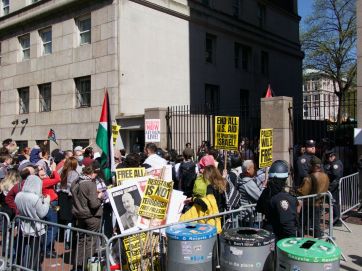This is the transcript of a talk NAS Policy Director Rachelle Peterson delivered in New Orleans, Louisiana, at the Heartland Institute’s America First Energy Conference on August 7, 2018. Watch her speech online here.
Last year, in May 2017, the Fossil Fuel Divestment Student Network, or the DSN, shut its doors. It graduated its last class of DSN Fellows, disbanded its staff, and ceased one of its core forms of activism: tweeting.
Its website, studentsdivest.org, closed down, and the domain name has since been bought by a Bitcoin enthusiast who advises how to make your fortune on crypto-currencies.
Five years ago, when the Divestment Student Network was founded, fossil fuel divestment was well on its way to becoming the darling of the far left. The student organizers were profiled in the New York Times and on NPR. Bill McKibben, Bernie Sanders’ go-to environmental advisor and a bestselling author of titles such as The End of Nature, had just finished a nationwide speaking tour called “Do the Math.” And McKibben’s organization, 350.org, named for the number of carbon dioxide parts per million that McKibben deemed safe, had just launched a new spin-off organization called Go Fossil Free.
The movement had the fervor of a religious revival and the practical advantages of a well-funded political machinery. In 2014, the divestment movement won an endorsement from President Obama. Over the next few years, it convinced major institutions like Georgetown University and Pitzer College to pledge to divest. Everything indicated the movement would succeed.
And yet last year the DSN closed down. In part, divestment was driven out by the rise of new movements like Black Lives Matter and Me Too. But in an email announcing the DSN’s end, lead organizer Greta Neubauer cited something else, something she called “a new age of American politics.” The 2016 election upended the DSN’s plans. It brought a new national policy focused on America first—not “feel good activism” first.
Still, the death of the divestment movement is not a total victory. The environmental left has been badly wounded, but it is not dead. To understand where it is going next, it’s worth looking a little more closely into where the divestment movement came from.
In 2012, when Bill McKibben toured the country advising activists to “do the math,” he was borrowing calculations from the Carbon Tracker Initiative, a London group of environmentalist financial analysts who came up with the concept of a “carbon bubble.” They estimated that in order to stay below a 2-degree rise in temperatures, it would be necessary to leave 80 percent of fossil fuel reserves in the ground, stranding the majority of the corporations’ assets. Once the necessary regulations were in place to forbid the use of those energy sources, the value of coal, oil, and gas companies would plummet.
The Carbon Tracker Initiative didn’t recommend divestment, but McKibben took their argument a step further. In an article for Rolling Stone called “Global Warming’s Terrifying New Math,” McKibben wrote, “Given this hard math, we need to view the fossil-fuel industry in a new light. It has become a rogue industry, reckless like no other force on Earth. It is Public Enemy Number One to the survival of our planetary civilization.” He called on investors to abandon them.
McKibben found a particularly eager audience among students, some of whom had already dabbled in divestment campaigns. In Pennsylvania, Swarthmore College students had formed a group called Swarthmore Mountain Justice to express solidarity with the people of West Virginia, whom they believed to be victims of mining companies. A professor, George Lakey, had taken students from his “Strategy for Nonviolent Activism” class on a fall break trip to West Virginia, where they held protests against coal mines.
At one protest, they erected a pile of dirt and a stop sign in the lobby of a PNC Bank, and sat down around the pile to hear a performance by the choir of the Church of Life After Shopping. They held a sign that read, “PNC: The Mountaintop Removal Bank,” and then went home.
Once back on campus in Pennsylvania, Lakey’s students couldn’t come up with much they could do about coal mines in West Virginia. But they had been studying about the 1980s divestment campaign against Apartheid South Africa, and decided they could try the same tactic. The following semester they launched an effort to persuade Swarthmore College trustees to eliminate any trace of fossil fuel companies from the college endowment.
Swarthmore became ground zero for the fossil fuel divestment movement, which grew into a national campaign with a network of professional organizers bankrolled by billionaire Tom Steyer and overseen by McKibben and his student acolytes. Steyer in particular was an unusual convert. The hedge fund manager and coal baron had arranged for a one-on-one hike up the Adirondacks with Bill McKibben. He came down persuaded to become a major funder of McKibben’s work.
The Divestment Student Network’s role was to give the professionally managed campaign the grungy, homegrown feel of a spontaneous student uprising. It also played a key role in recruiting and training students, planning sit-ins and marches, and organizing the ever ongoing tweet fests.
Swarthmore College never did divest, despite some heated campaigns on campus. Swarthmore Mountain Justice held a 32-day sit-in for divestment, collected endorsements from four academic departments, and even managed to hijack a public board meeting. Having persuaded the board that meeting in private was undemocratic and elitist, the student then swarmed the room, holding signs that read “Check Ur Ignorance.” They grabbed the mics, and lectured board members for more than an hour about the need not only for fossil fuel divestment, but for amnesty for illegal immigrants and the need for more racial diversity among the student body.
College administrators are not known for their courage, but during that board meeting, Swarthmore’s administration reached a new low. They cancelled the agenda and sat silently while the students ranted. When another student in the audience, Danielle Charette, who was opposed to divestment and to the hijacking of the meeting, walked to the front of the room to ask President Rebecca Chopp to intervene, Chopp and all other administrators declined. They watched silently while the activists accosted Charette and yelled, “You are also free to leave!”
Though Swarthmore College did not divest from fossil fuels, some 150 or so other colleges and universities did—or at least said they did. Many, if you scrutinized the fine print, wrote their divestment pledges in terms that signaled no change in investment strategy whatsoever. I call these DINOs—divestments in name only.
But Swarthmore did something else. It attempted to placate the student activists with pledges to go “carbon-neutral,” devote more class time to teaching about global warming, hire its first campus Sustainability Director, and engage in shareholder activism.
Swarthmore’s decision is one that hundreds of colleges and universities have made: the decision to decline to divest, but also to instead invest significant campus resources into perpetuating the machinery of global warming alarmism.
That makes the death of the Divestment Student Network, and the decline in fossil fuel divestment fervor, only a partial victory.
American colleges and universities have held firm on their objections to fossil fuel divestment, in large part because of concern for the financial losses it will bring. In 2015, in a report for the National Association of Scholars, Inside Divestment, I scrutinized every single decision by a college or university for or against divestment. 66% of the colleges that refused to divest cited the costs. Swarthmore’s board chairman Gil Kemp calculated Swarthmore might lose $10-15 million a year by divesting.
About a third of the colleges and universities—31%—specifically cited their “fiduciary duty” to raise funds for academic purposes, not to waste those funds on activism. A similar number of colleges said donor intent mattered, and the donors who funded the endowment had not approved using the endowment as a political billboard.
A handful of colleges cited the necessity of using fossil fuels in our modern economy as a reason not to divest. About a third acknowledged that divestment was politically motivated and therefore inappropriate for an institution of higher education.
But, alarmingly, the single most popular reason colleges gave in declining to divest was that pulling out endowment investments from fossil fuel companies was futile. It did nothing to stop global warming, cut carbon dioxide emissions, force companies to change their business models, or institute a carbon tax. 79 % said divestment was ineffective at achieving its stated goals. And 59%, like Swarthmore, pledged to substitute other forms of environmental activism, either by teaching more classes about global warming and sustainability or decreasing consumption of energy. Others said they would engage in shareholder activism.
In other words, colleges and universities rejected divestment not because they rejected the values and goals of the divestment movement, but because they disliked the tactic. They agreed with the student activists in calling for the abandonment of coal, oil, and gas. They, too, wanted to enact strict environmental regulations. And they also believed that anthropogenic global warming was not only true but also the single most important issue in today’s society. They just didn’t think divestment would accomplish those goals.
That’s why the shuttering of the Divestment Student Network is not in itself cause to rest easy. The fossil fuel divestment movement is in decline on college campuses, though it remains active against pension funds and other investments. The environmental left has faced big reversals, but it is not dead.
The divestment movement is alarming not only because it displays an astonishing indifference to economics, but also it because it rejects a core tenet of the American representative democracy: the idea that our political system is created with checks and balances, in a structure that is set up to be fair and to be respected.
That may sound like an overstatement, but it’s not. The central premise of the divestment campaign is the idea that the political system is set up to favor the rich and well-connected at the expense of the environment. Not just that it has become corrupted and needs to be called back to its original principles, and not just that it has been misled and needs to be redirected. But that the idea of a democratic republic is itself elitist and immoral and therefore worth protesting, obstructing, and hijacking in an effort to enact strict environmental regulations.
That premise polarizes what should be a legitimate debate about how best to treat the environment. It assumes that anyone who favors free markets is a mere mercenary for big business. And it asserts that mob rule by street-marching, live-tweeting activists is better than free and civil debate.
The fossil fuel movement not only advocates a deeply flawed environmental policy. Worse, it trains a generation to disdain representative government. It replaces a college education with four years of misguided activism.
Perhaps it is no surprise, then, that the DSN’s staff have regrouped to start a new organization called the Sunrise Movement, which recruits and supports openly socialist candidates for office. One of their endorsees, Alexandria Ocasio-Cortez, won a Congressional primary in New York City, beating out a ten-term incumbent and the #4-ranked House Democrat. Ocasio-Cortez has vowed to support a “Green New Deal” and 100% renewable energy.
So we should celebrate the demise of the Divestment Student Network, but we should not think our work is done.
NAS’s 2015 report Inside Divestment: The Illiberal Movement to Turn a Generation Against Fossil Fuels, offers the most in-depth account of the fossil fuel divestment movement.
Photo: By James Ennis - CC BY 2.0













